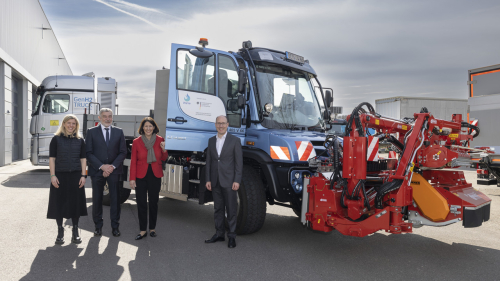
At this year’s demopark open-air exhibition, Mercedes-Benz is presenting a prototype of the Unimog based on the U 430 with hydrogen-powered combustion engine as part of the publicly funded “WaVe” project.
The project, funded by Germany Federal Ministry for Economic Affairs and Climate Action, is being implemented jointly by 18 partners from industry and science and began in July 2021. The consortium leader is Mercedes-Benz Special Trucks, administrative control is in the hands of Commercial Vehicle Cluster Nutzfahrzeug GmbH.
The hydrogen engine is provided by Keyou and is equipped with H2PFI injectors made by Hoerbiger. (The two companies signed a cooperation agreement early in 2022 aimed at the joint development, production and commercialization of injectors for hydrogen engines, with a focus on PFI for the heavy-duty sector.)
After the first test phase of the H2 engine was successfully completed on the test stand in autumn 2022, the engine—together with fuel tank, safety and monitoring systems—were installed in the Unimog at the turn of the year, and initial tests in driving operation were carried out. In the second quarter of 2023, the prototype will be equipped with a body implement for mowing in order to then gain further insights into work mode.
The aim of the WaVe project is to examine the extent to which the tasks of a conventional diesel engine as a multi-power distributor for the traction drive and all power take-offs (PTOs) can also be performed by a hydrogen-powered combustion engine in the future.
This variant could prove to be a possible alternative drive type for the Unimog. This is because the implement carrier places high demands on output, performance and payload. However, as space is limited, the installation of a purely battery-electric drive or hydrogen-based fuel cells would be challenging.
By 2039, Daimler Truck intends to offer only climate-neutral new vehicles in driving operation in its core global markets (EU30, USA and Japan). In order to achieve this objective, the company has clearly set the strategic course for itself and is consistently pursuing a dual strategy in the electrification of its portfolio: with battery and hydrogen-based drives.
In addition, by the end of June 2024, for research purposes, complementary drive systems such as hot hydrogen combustion in the piston engine for the Unimog will be investigated as part of the aforementioned WaVe joint venture.
Unimog. Specifically developed for implement use, the Unimog in association with many qualified body partners offers individual system solutions that can increase both productivity and the capacity utilization of a fleet. Standardized and normed interfaces ensure quick implement changes. The U 535 and U 435, among others, showcase this at demopark.
The U 535, the heaviest and most powerful Unimog model series, can be seen here with a rear-mounted mower without additional axle locking from Unimog ExpertPartner Mulag. Last year, the Unimog and Mulag were able to look back on a 50-year collaboration. At the trade fair, the U 435 can be seen with a spreader from Bucher Municipal. Both vehicles are equipped with a diesel engine with an output of 260 kW (354 hp).
In the Unimog, the fully synchronized electropneumatic manual transmission translates the output of the maintenance-friendly, economical, smooth-running and high-torque Euro VI engines into propulsion. The synchronized Electronic Quick Reverse reversing group makes it easier to change direction quickly, for example when clearing or maneuvering.
Comfort steering also offers high added value—it reduces the steering forces at low speeds and when the vehicle is stationary. This is particularly advantageous when working with heavy-duty front-mounted implements such as mowing combinations or large-volume tires. The electrohydraulic system adapts to the respective driving situation depending on the speed. The comfort steering thus generates a variable steering feel adapted to the driving situation.
To make working with the Unimog even more efficient and comfortable for customers, the vehicle is optionally available with hydropneumatic suspension on the rear axle. Here, gas is compressed or expanded by a change in oil volume, which creates a resilient effect. In conjunction with hydraulic cylinders, spring accumulators, hydraulic valves, sensors and control unit, the hydraulic spring enables a more stable driving behavior in addition to the constant driving level under a wide range of load conditions or heavy rear-mounted implements. Ride comfort is significantly increased, particularly for one-sided loads and when cornering. At the same time, the system assist when coupling and uncoupling attachments—it makes work easier and reduces set-up times when changing implements.